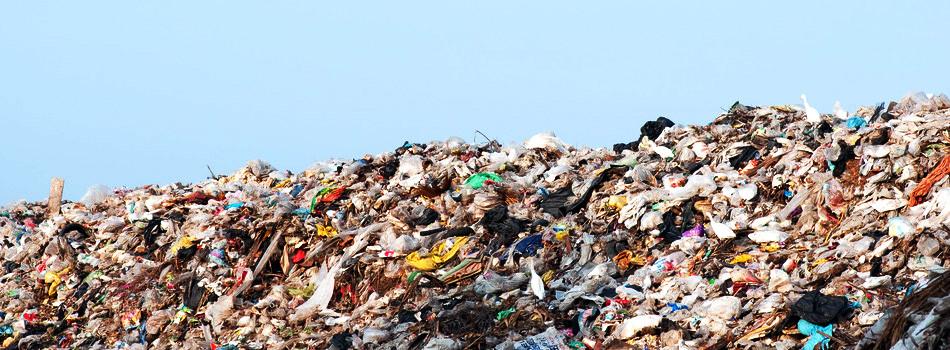
Image by Recycling Textile Management via rtmrecycling.com
The CRD reported over 8,000 tonnes of textiles making it to Victoria’s landfill last year—that’s around 46 lbs per capita. According to the Vancouver Sun, Canada’s yearly textile waste, including upholstery and clothes, could create a mountain three times the size of Toronto's Rogers Centre Stadium. That would pile more than twice the height of Vancouver’s TD Tower.
Why are we throwing away clothing that could easily be reused or recycled? Creating new clothing fabric has a serious environmental impact. In fact, making any fibres into fabric, natural or synthetic, has a substantial negative effect on the Earth. This is because fibres must be knitted or woven, dyed, and finished before they actually become fabric—processes that require large amounts of energy, water, and harmful chemicals. The Natural Resources Defense Council, an international non-profit devoted to environmental advocacy, states that no fibre can be classified as the least damaging to the Earth, aside from recycled content.
The environmental effects of fabric creation is even a concern in the realm of high fashion. “The clothing industry is the second largest polluter in the world, second only to oil,” says designer Eileen Fisher in a widely-cited article from Ready To Wear magazine.

Graph by James Mills, Business Manager of Polyester and Intermediates, Tenon OrbiChem. Image va art quill.blogspot.ca
Without recycling textiles, new fabrics are created in abundance. Large quantities of new materials are made quickly to accommodate fashion trends. Retailers often rely on the aesthetics and functions of new fabrics consisting wholly or partially of synthetic fibres, despite the capabilities and benefits of natural and recycled fabrics. This is often because sourcing natural, organic, or recycled material can be more expensive and less convenient for manufacturers—but consumers have the power to demand change.
Alan Wheeler of the Textile Recycling Association reports, “More work needs to be done on persuading the public that they don’t need to buy new clothes every six weeks. But we should also be encouraging people to pay more for their clothing and use it for longer.”
In a perfect world, we might create clothing from natural and organic sources and recycle those pieces until they decompose.
Natural fibres

Corriedale rams in full wool. Image via woolshed1.blogspot.ca
Both fabric make-up and the longevity of garments matter for the Earth when we choose new apparel. While the creation of both natural and synthetic fibres is hard on the planet, natural fibres are long-lasting, durable, and 100 per cent biodegradable at the end of their life. Think of synthetic fibres as plastic fibres: they result from a similar fusion of chemical materials. The downside of making plastics into small threads is that they inevitably float into the natural world (our food and water sources) as garments are worn and cleaned.
These microfibres are found in oceans, fresh water, and aquatic life. In 2011, research from the University of South Wales, Australia showed that microfibres made up 85 percent of human-made debris on shorelines around the world.
Microfibres are small enough to be easily consumed by wildlife. Vancouver Island University biologist Sarah Dudas told the CBC that examining local juvenile salmonids (salmon, trout, char, etc.) revealed microfibres weaved inside their internal tissues.

Close-up of microfibres, measuring under 1500 micrometers. Image via DebrisFreeOceans.org
Leah Messinger for the Guardian newspaper reports that microfibres have the potential to bioaccumulate and concentrate toxins in the bodies of animals higher up the food chain. Although America recently banned microbeads in cosmetics, microfibres have recently been found to be more pervasive, writes Messinger.
Recycling can be done now
The cyclical benefits of choosing natural and organic fibres could be the better in the long-term but only accompanied with a decrease in new fabric production. The best way to reduce harm immediately is to simply invest and participate in recycling. You can help by purchasing garments made from recycled fabrics. Alternatively, increasing the longevity of a garment’s life is easy as buying second-hand clothes and donating to thrift shops.
There are several local second-hand retailers that accept donations for re-selling including the Salvation Army, Value Village and the Patch. Flavour Upstairs is a vintage shop that will actually pay for used garments provided the clothes have some old school style. It might be easier to to reach the garbage can than a thrift shop’s donation centre, but the Earth is in need of our extra effort. If your garments are un-sellable, try getting creative: use them for rags around the house.
There are steps being taken by the clothing industry to ensure better textile disposal and the actual dismantling and recycling of fabric. Take it from debrand, an organization devoted to large-quantity secure disposal of waste material. debrand works with clothing companies who have damaged or defective goods that cannot be donated or resold. Popular retailers like Aritzia and Patagonia pay debrand to keep defective clothing out of landfills and into proper recycling facilities. Non-reusable textiles can be shredded and made into basic materials for home furnishing, automotive, and paper industries.
debrand acts as a consolidation point that deconstructs and allocates materials to various specialized recycling centres for glass, textiles, plastics, etc. “[We] provide security for brands, to ensure their clothing doesn’t end up where it’s not meant to be, whether that’s in a landfill or sold on a black market,” says Co-Founder and Director Amelia Ufford, “It’s essentially protecting the environment and your brand.”
Sitka also exists to push the inevitable textile industry toward eco-responsible practices. We create long-lasting garments from recycled, natural and organic materials. In the future, Sitka plans to operate as a fabric recycling centre, providing both the deconstruction of old garments as well as a creation site for making them new again.

Sitka and Faribault recycled wool blanket. Photo by Nick Gittins.
Our harmful overconsumption of apparel derives from a basic need to protect our bodies. But when choosing clothes, it’s important to ask how can we do more with less.


